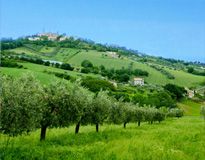The birth of ceramics in the village of Castelli is mainly due to the natural characteristics of the territory, in particular the abundant presence of clay pits, beech forests for wood and furnaces, water courses, silica deposits. The ceramic tradition developed in Castelli already in Etruscan times and then favored by the presence of Benedictine monks who produced furnishings for daily use. In the territory, traces of ancient ceramics belonging to the most remote eras demonstrate how the rise of a manufacturing tradition has not blossomed from nothing, but has had its prehistory and its protohistory. During the Middle Ages, with the actual birth of the inhabited nucleus, ceramics production certainly started, at least for common dishes. It is the opinion of many scholars that an important role must have taken the Benedictine Abbey of San Salvatore, connected with the style of other Italian centers.
Between the end of the fifteenth and the beginning of the sixteenth century the castellan factories already had a certain turnover and engaged in cultural exchanges with other centers of the peninsula, including Faenza and Naples.
The engobed and graffiti production is abandoned in the first three decades of the sixteenth century, following the decisive impulse of the Pompeii workshop, thanks to which the castellan ceramic products are transformed from imitations linked to local consumption in original morphological and decorative expressions. At the top of the Renaissance production of Italian and European centers is "The Madonna who suckles the child", more strictly pictorial work of Orazio Pompei of 1551, the most important monument dating from the castellan art.
The 1989 exhibition "The sixteenth-century majolica of Castelli" held in Pescara also definitively marked the attribution to Castelli of the Orsini Colonna trousseau, also attributable to the Pompeii workshop. The most extraordinary monument of Castelli's majolica, defined by Carlo Levi as "The Sistine of Italian Majolica" is the ceiling of the church of San Donato, dated 1615-1617, a real turning point of the castellan ceramics. With the beginning of the seventeenth century, with the debut of the new style inaugurated by the compendiary - historiated of San Donato, begins the second golden season of the majolica castellana, mainly by two dynasties that for nearly two centuries will keep the name of the small Abruzzese center high, that dei Grue and that of the Gentile, spreading the production also in other centers. In addition there are other families of potters, such as Cappelletti, De Martinis, Fraticelli, the Warriors, the Pardi, the Fuina.
With the nineteenth century the artistic message of Castelli is in danger of disappearing due to the competition of porcelain, the pressing industrial production and, above all, for the sunset of the traditional workshop, where artistic and technical training took place.
The foundation of a school was then proposed to re-educate young people in the art of drawing. After a first attempt, not very long lasting in 1847, the "School of Art applied to Ceramics" was founded in 1906, which in 1960 became the State Art Institute for Ceramica F.Grue. Since then, the recovery of the local tradition of great historical-artistic importance, continues to be a source of inspiration for the current production of numerous craft factories, shops and laboratories, which offer a wide range of types and styles, from the reworking of motifs sixteenth and seventeenth century to the most current proposals.
 en
en 














